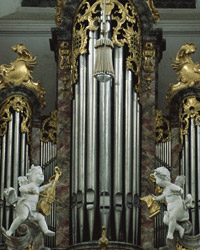instrument: Organ
 Although played with a keyboard, the organ is actually a wind instrument – where the sound is produced when air passes through pipes of varying sizes whose valves are opened or closed manually by means of stops. The source of the airflow has varied through the years – originating in Greco-Roman times with water-pressure (i.e., the hydraulis), and later evolving in the Middle Ages to wind powered by weighted bellows. Medieval organs were quite simple, with limited ranges and pitch orientation. Initially, they were used as an aid to music theory, for improvisation, or occasionally to accompany vocal performance. With the rise of polyphony in the 13th and 14th centuries, however, composers began to utilize the organ – and other keyboard instruments – in new ways, making instrumental transcriptions of vocal works as well as original works, such as dances. This literature grew considerably with the advent of music printing in the early 16th century: at first, the dominant portion was based on liturgical chant, and thus intended for use within a church service, especially the Mass; but increasingly during the latter Renaissance arose a repertory of forms based on elaborations of vocal works – such as the ricercar and the canzona, as well as new genres that highlighted a more purely “instrumental” approach – such as the fantasy and the prelude. Among the principal late-Renaissance and early Baroque composers of organ and early keyboard music include the Venetian composers Giovanni Gabrieli and Claudio Merulo; the English composers John Redford, Thomas Tallis, and William Byrd; and the Spaniard Antonio de Cabezón.
Although played with a keyboard, the organ is actually a wind instrument – where the sound is produced when air passes through pipes of varying sizes whose valves are opened or closed manually by means of stops. The source of the airflow has varied through the years – originating in Greco-Roman times with water-pressure (i.e., the hydraulis), and later evolving in the Middle Ages to wind powered by weighted bellows. Medieval organs were quite simple, with limited ranges and pitch orientation. Initially, they were used as an aid to music theory, for improvisation, or occasionally to accompany vocal performance. With the rise of polyphony in the 13th and 14th centuries, however, composers began to utilize the organ – and other keyboard instruments – in new ways, making instrumental transcriptions of vocal works as well as original works, such as dances. This literature grew considerably with the advent of music printing in the early 16th century: at first, the dominant portion was based on liturgical chant, and thus intended for use within a church service, especially the Mass; but increasingly during the latter Renaissance arose a repertory of forms based on elaborations of vocal works – such as the ricercar and the canzona, as well as new genres that highlighted a more purely “instrumental” approach – such as the fantasy and the prelude. Among the principal late-Renaissance and early Baroque composers of organ and early keyboard music include the Venetian composers Giovanni Gabrieli and Claudio Merulo; the English composers John Redford, Thomas Tallis, and William Byrd; and the Spaniard Antonio de Cabezón.
The mid- to late-Baroque era is surely the “golden age” of organ music – aided by considerable improvements in the range and power of the sound, with a vast increase in the variety of tones and “instruments” supplied by the stops, increased size and numbers of manuals, improved key and pedal action, etc.; the instruments likewise became the object of tremendous artistic effort, as witnessed by the many glorious pipe organs built across Europe in the 17th century. Such developments, and the accompanying rise of instrumental music in general, resulted in an increasing distinction – in genre, style, and technique – between organ music and music for other keyboard instruments, such as the virginal and the harpsichord. The former maintained its close association with liturgical music, and a musical kinship with vocal music – e.g., via a strict number of voices (melodies) within a contrapuntal work. Among the principal composers of organ music in the Baroque include John Blow, Jan Sweelinck, Samuel Scheidt, and Dietrich Buxtehude – who had a major influence on the greatest organ composer of the era, J.S. Bach. A majority of their organ output, again, is religious in nature, with those in Protestant countries (esp. Germany) generally based on Lutheran chorales (e.g., chorale preludes); secular organ music included, especially, the fugue, as well as such genres as the prelude, the passacaglia, fantasias, and toccatas – the latter two highlighting the virtuosic potential of the instrument.
A serious decline in the composition and performance of organ music befell the Classical and early Romantic eras, largely a result of the waning influence of the Church in general in musical life; where it did thrive, the continuing influence of J.S. Bach was paramount. A more serious resurgence came in the late 1830s and 1840s, with the organ works by Felix Mendelssohn and Franz Liszt, and especially among the late-Romantic composers Cesar Franck, C.M.Widor, and Max Reger – all of whom adopted a more “symphonic” approach to writing for the instrument, while not abandoning its association with liturgical usage. Among Modern and Contemporary composers, the organ has generally maintained a marginal position, with a few notable exceptions, especially in France – with composers such as Maurice Duruflé and especially Olivier Messaien, whose organ music reveals the power of this “king of instruments” to intersect the realms of philosophy and religion – a power that continues to call a small but dedicated following of composers.

Nolan Gasser, PhD
Artistic Director













